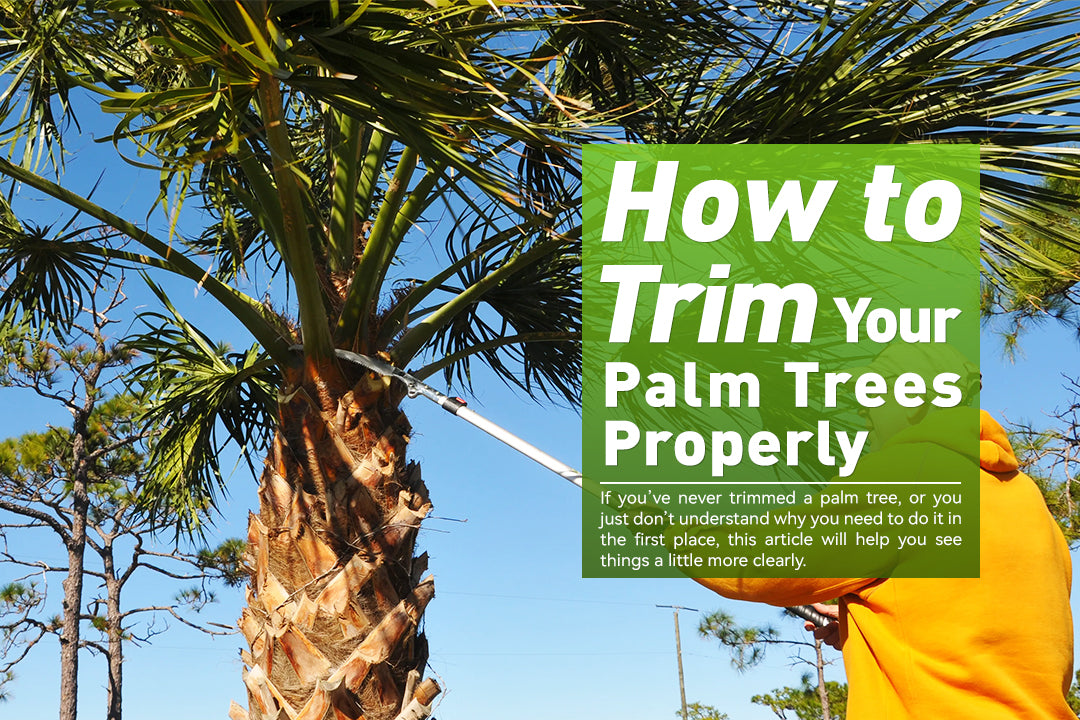Palm trees, renowned for their elegant fronds and distinctive profiles, are a fixture in many landscapes. Adequate upkeep is vital to maintaining the health and appearance of these trees. Among the essential practices in palm tree care is trimming. Pruning your palm trees is not only conducive to their visual appeal but also contributes to their overall wellness. Not to mention it will aid you in pest control. I can’t tell you how many times I have heard people complain about rat and squirrel problems in their backyard. All because they didn’t trim their palm trees!
So, if you’ve never trimmed a palm tree, or you just don’t understand why you need to do it in the first place, this article will help you see things a little more clearly.
- Grasp the Reasons and Timing
Before embarking on the task of trimming your palm trees, it is imperative to comprehend the motivations behind this practice and the opportune moments to execute it. Trimming serves various purposes, such as eliminating deceased or dying fronds, boosting air circulation, and averting potential safety risks. The removal of deceased fronds is particularly critical, as they can transform into breeding grounds for pests and diseases.
Concerning timing, the optimal period for trimming your palm trees generally falls during the warmer months, such as spring and early summer. It is advisable to avoid trimming during the fall and winter when palm trees tend to be less active. Engaging in trimming during the active growth season enables the tree to recuperate more swiftly and minimizes stress.

- Assemble the Appropriate Tools
Equipping yourself with the right tools can substantially facilitate the trimming process, rendering it more efficient. Some indispensable tools encompass:
- Pruning shears: Employed for smaller fronds and minor trimming.
- Loppers: Devised for thicker fronds and branches.
- Pole pruner: Ideal for reaching elevated fronds without the use of a ladder.
- Chainsaw: Essential for larger and more resilient branches, though caution must be exercised during its use.
It is imperative to ensure that your tools are sanitized and well-honed prior to initiating the trimming process to avert tearing or damaging the fronds.
- Prioritize Safety
Safety should perpetually remain a focal point when engaged in tasks involving trees. In cases of towering palms, contemplating the use of a harness and safety ropes is advisable. If a ladder is utilized, guaranteeing its stability on level ground is essential. Donning suitable safety attire such as gloves, eye protection, and a helmet is also crucial.
- Discern Deceased Fronds
The primary step in the trimming process is identifying which fronds necessitate removal. Deceased or brown fronds are readily discernible and should be the primary focus. These fronds no longer contribute to the tree's vitality and can even constitute a fire hazard in drier climates.

- Evade Excessive Pruning
While the removal of deceased fronds is imperative, excessive pruning can prove detrimental to the tree. Green fronds play a pivotal role in photosynthesis and the overall well-being of the palm. Eliminating an excessive number of green fronds can debilitate the tree and render it more vulnerable to diseases and stress. A prudent guideline is to abstain from removing more than 15-20% of the fronds during a single trimming session.
- Trim Flowers and Fruit Stalks
Certain palm species generate flowers and fruit stalks that eventually burden the tree. These structures can drain essential nutrients and energy. Pruning them can redirect these resources towards healthier growth. However, if you derive aesthetic satisfaction from the flowers and eventual fruit, the option of leaving them untouched is viable.
- Exercise Aesthetic Discernment
Trimming can wield considerable influence over the visual aspect of your palm trees. Taking into account the innate shape of the species during pruning is advisable. Some palms exhibit a more compact crown, whereas others boast an open and sprawling growth pattern. Striving for a harmonious and symmetrical appearance is commendable, though the health of the tree should always take precedence over aesthetics.

- Recognize When to Seek Professional Assistance
Although minor trimming can be undertaken as a do-it-yourself task, specific scenarios necessitate the involvement of a professional arborist. If you are contending with an exceptionally tall palm or if the trimming involves precarious maneuvers, enlisting the expertise of a skilled arborist with the requisite equipment and training is recommended.
Conclusion
In conclusion, proper trimming constitutes a fundamental facet of palm tree care. By comprehending the rationale behind trimming, utilizing the appropriate tools, prioritizing safety, and exercising consideration for the tree's health and aesthetics, you can uphold healthy and visually captivating palm trees within your landscape. It is important to remember that the objective is not solely to attain an appealing appearance, but also to augment the overall vitality and longevity of these iconic trees.


